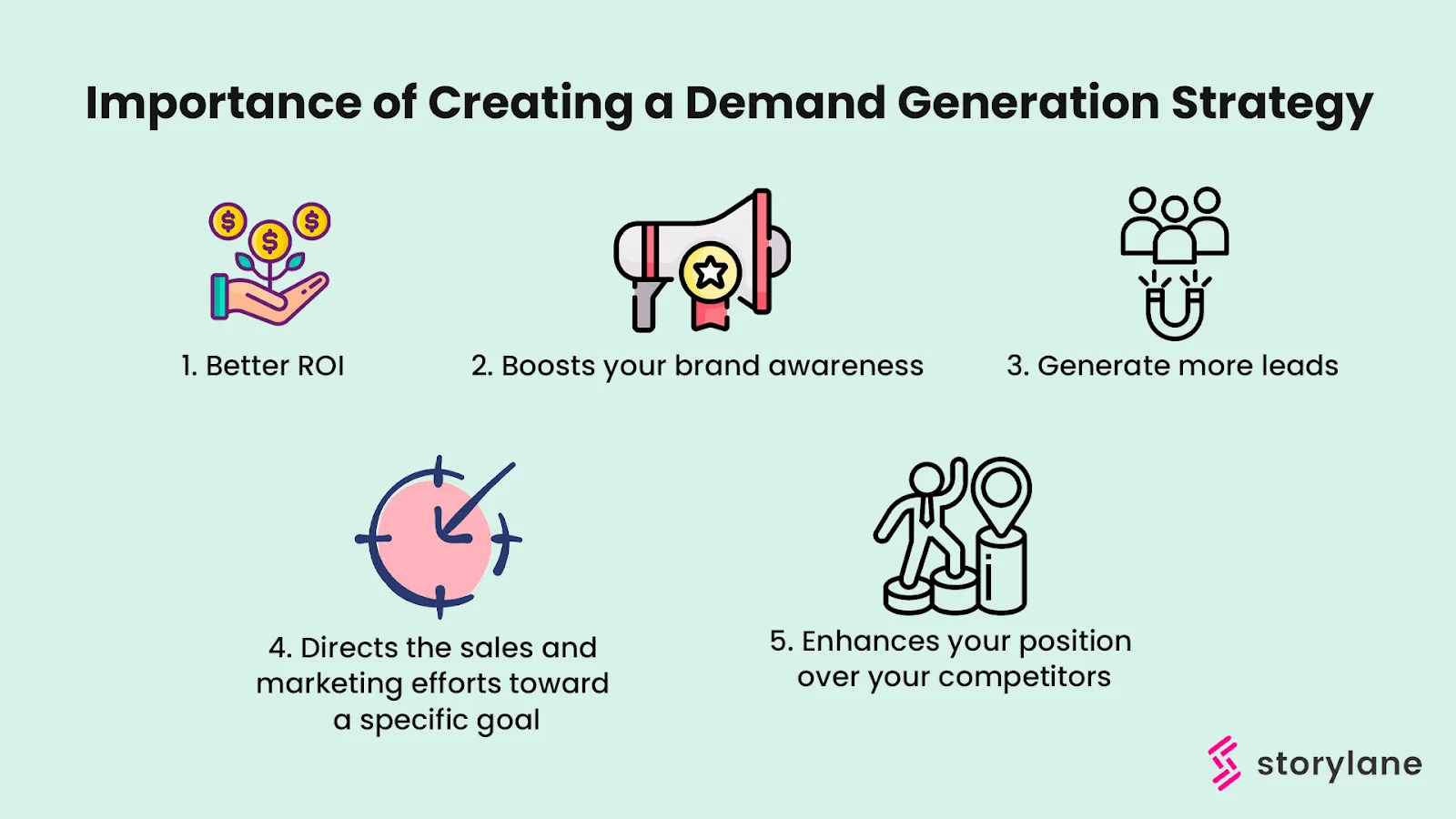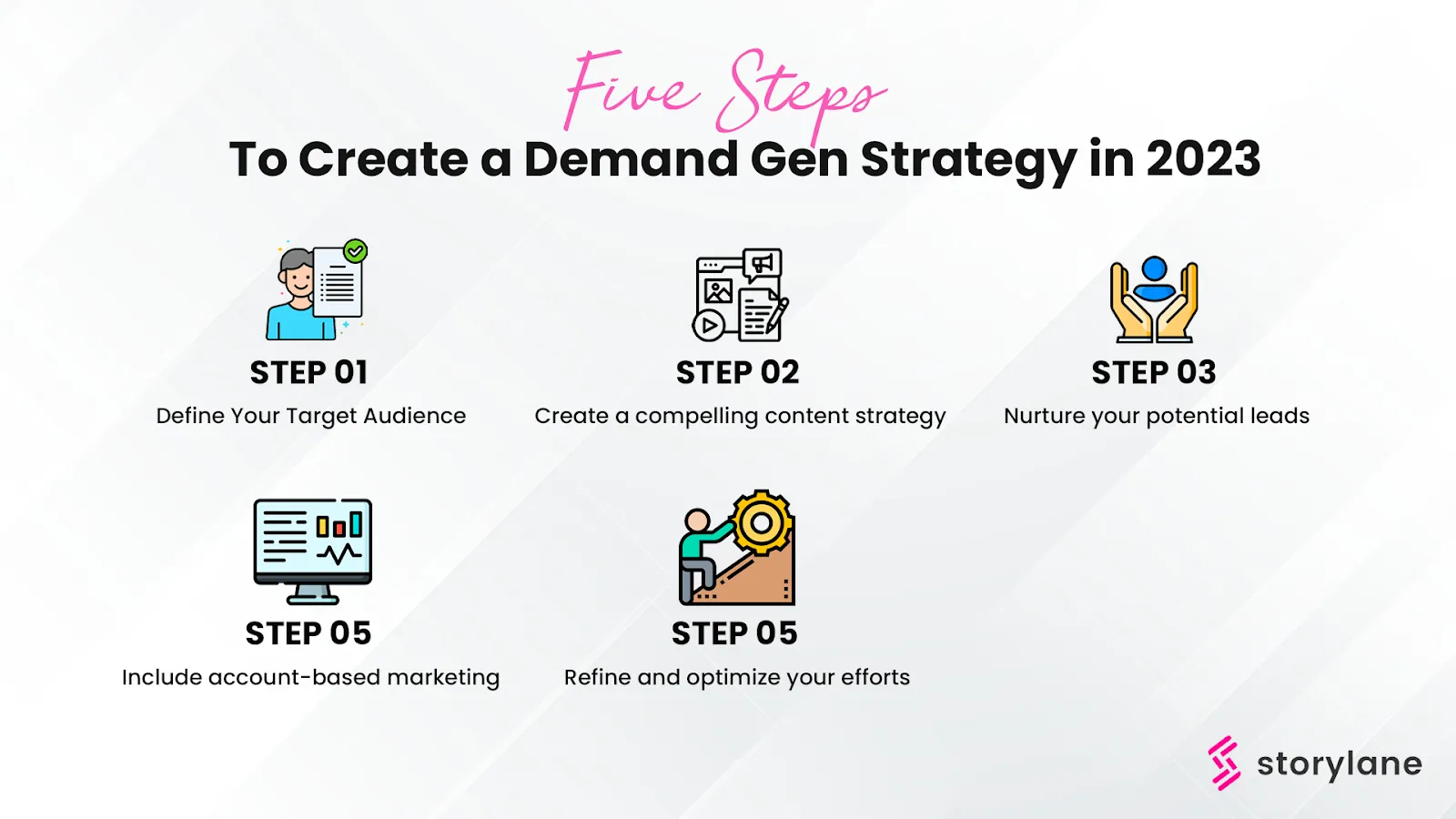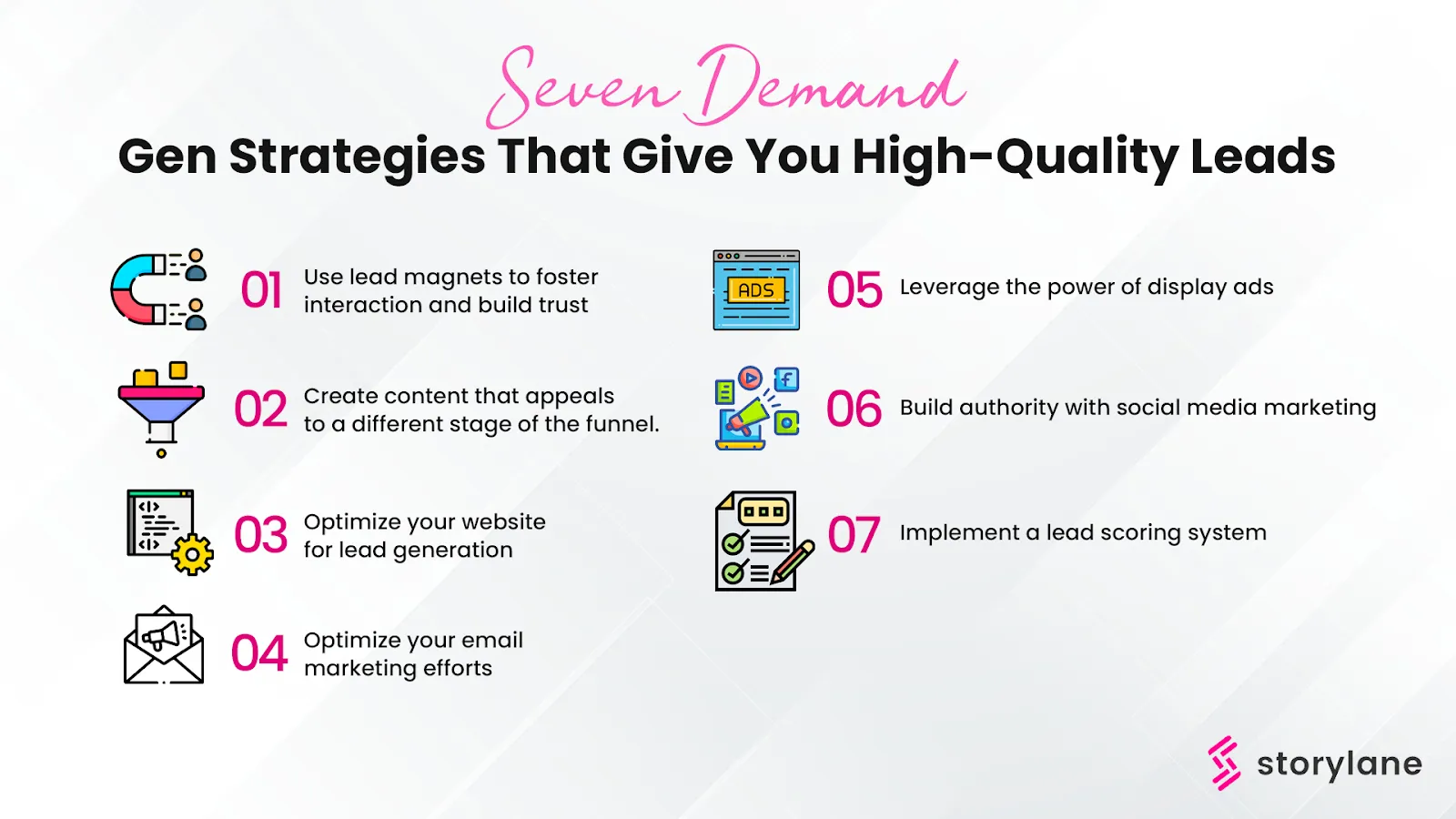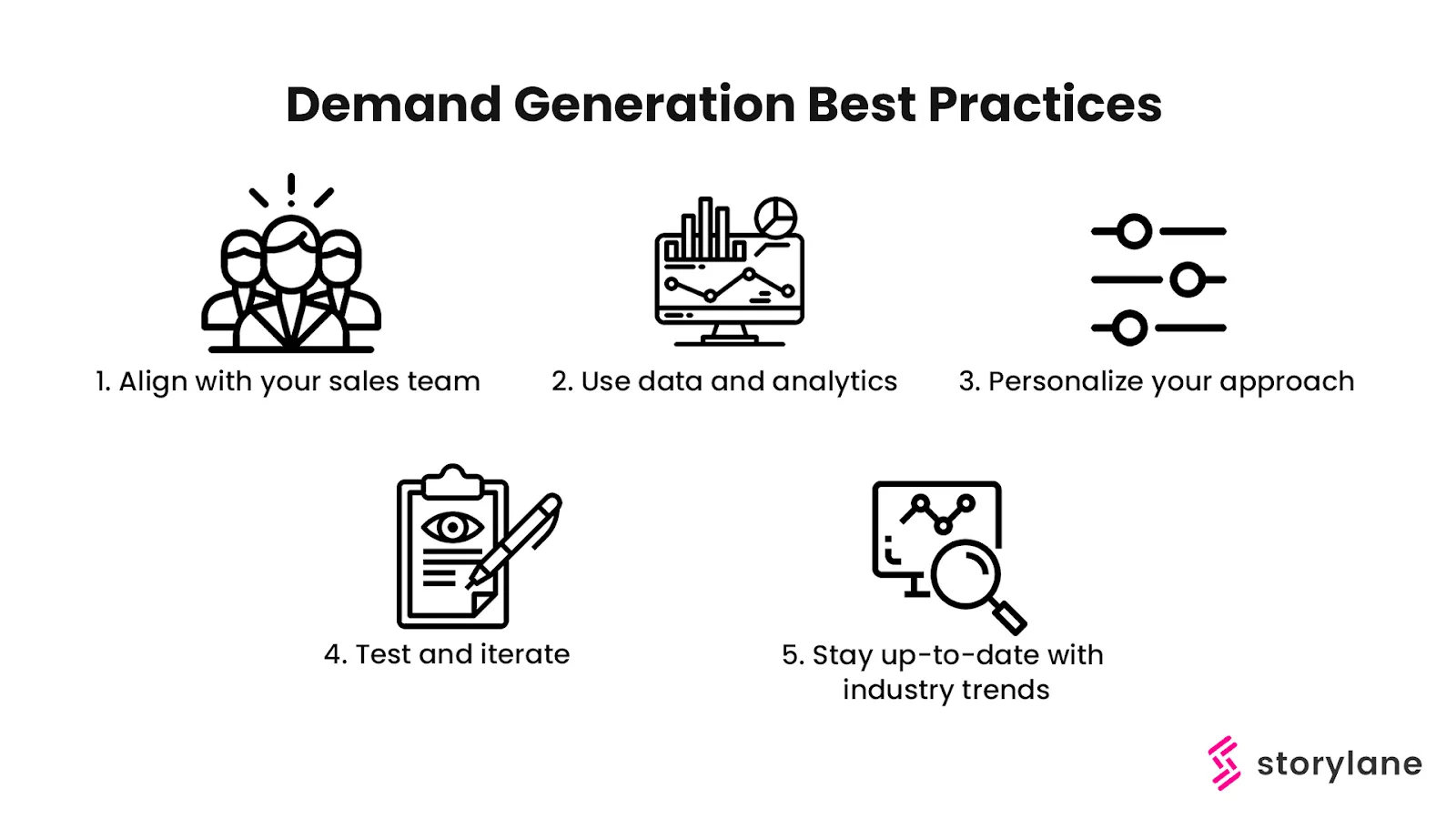How do you connect with new customers?
It’s an age-old problem: connecting your offerings to consumer desires. It’s a challenge that every business faces. And it’s getting more complex as customers are buried in more messaging from brands, retailers, publishers, and ad networks.
This is especially true for B2B brands, where the customer journey is longer, more complex, and harder to measure. You need a strategy that helps you cut through the noise, connect with customers at every touch point and deliver results.
The solution to this problem is demand generation: a process to engage with prospects and drive them through the sales funnel.
In this blog, you will learn how to build a demand-generation strategy to help you grow your business.
What is Demand Generation Strategy?
Demand generation is a marketing strategy focusing on creating demand for your product or service by attracting and converting quality leads. This marketing strategy aims to increase the number of sales opportunities to increase revenue and market share.
Demand gen can help a business make marketing pitches that are more authoritative and weighty, which in turn helps generate strong leads—and ultimately boosts revenue. After all, why will customers resist the offer when they believe that you are the one they need to grow their business?

Generating demand can help you create a predictable pipeline for your sales teams. The primary goal is to move prospective clients through the buyer’s journey. It is generally divided into three significant stages- awareness, consideration, and decision – until they convert into qualified leads.

Importance of Creating a Demand Generation Strategy.
Demand generation is more effective in building a qualified lead pipeline than traditional lead generation methodologies. It’s because the method provides you with information about your prospects and their needs, which can be used to create compelling content that resonates with them.
Here are the reasons why it’s essential to have a demand generation strategy in place:
1. Better ROI.
Creating a demand generation strategy allows your team to spend less time and money on lead generation efforts. It will help you create content that is more likely to appeal to your target audience, and therefore, increase the conversion rate of your campaigns.
Moreover, you’ll be able to identify the most lucrative channels for lead generation. This will allow you to focus on them and increase your ROI.
2. Boosts your brand awareness.
It helps you build brand awareness and generate interest in your products or services. The more people you reach, the more likely they will remember your brand when the time comes for them to make a purchase decision.
By informing and educating your customers, a well-executed inbound marketing campaign can raise awareness of your value. By exposing potential customers to your products and services in content pieces, you increase the likelihood that they will seek you out—once they realize how essential your product or service is.
3. Generate more leads.
Although demand generation is not the same as B2B lead generation (lead gen is one part of the demand and generally focuses on the top of the funnel), a well-rounded demand plan should increase leads.
As more prospects become aware of your brand and its value, they will likely engage with you. This could be a phone call or email inquiry, or it may mean that they visit your website and fill out a form.
Either way, leads are crucial to driving sales, so increasing demand for your product or service can increase leads.
4. Directs the sales and marketing efforts toward a specific goal.
While many companies struggle to align their marketing and sales efforts, a demand plan can help accomplish this goal.
By creating a clear-cut strategy that focuses on the customer’s needs and wants, your company can create better outreach content. This will help sales and marketing teams understand how their efforts fit into the larger picture of your business.
5. Enhances your position over your competitors.
Creating a demand generation plan will allow you to establish your business as the go-to resource in your industry. This will help you stand out from competitors who may not have thought through their marketing strategy.

Explore the b2b demand generation campaign examples.
5 Steps to Create a Demand Gen Strategy in 2023
With marketing trends changing rapidly, staying ahead of the curve is essential. A demand generation strategy will help you identify your target audience and create content that resonates with them. This will help you build an effective marketing plan that drives leads and sales for years.
Let’s look at the five critical steps you need to take to build a successful B2B demand generation strategy.
1. Define your target audience
This is the first step and the most important one. It’s essential to understand who you’re trying to reach and how they want to be marketed to. Since your goal is to generate leads, your target audience should be specific enough that you can determine what their pain points are and how they feel about those pains.
Ask these questions to pinpoint your target audience,
- Who is your ideal customer?
- How can you better understand what they need and why they need it?
- What pain points are they facing, and how can you solve them with your products or services?
You may have already identified some of these answers when creating buyer personas. Now it’s time to dig deeper into the specific needs of each persona so that you know exactly who to target with your content.
2. Create a compelling content strategy.
Content strategy is about creating a plan for your content. It’s about knowing where you want your business and how content will get you there. It also includes ensuring that all the pieces fit together into a cohesive whole so that your brand storytelling is consistent across all channels (including social media).
If you provide content that answers buyer questions/concerns while they move through their purchase journey, customers will feel confident about purchasing from your company.
Begin by making a list of your customers' most common questions and concerns. This could be related to your products/services or more general topics. Once you've identified these questions/concerns, create content that answers them clearly and succinctly.
Then select the suitable platform where your customers are most active. For B2B demand generation, this could be LinkedIn. When writing your messaging, include information addressing the questions a buyer will have from their first encounter with your product or service to decide whether and how they want to buy.
3. Nurture your potential leads.
Marketers should create demand-generation campaigns that include a lead-nurturing strategy for various sales funnel stages. Buyer attitudes, needs, and concerns must be considered before selling a product.
To reach customers, marketing teams must unite with sales and collaborate to deliver their message through relevant content. To make this work, one needs to closely monitor lead feedback—and keep track of the stages that involve greater engagement levels among prospects or clients.
4. Include account-based marketing.
The most effective way to drive sales is using account-based marketing (ABM). ABM combines the power of data, technology, and creativity to focus on specific accounts and segments. It’s an ideal solution for B2B marketers who want to target their ideal customers more effectively than traditional methods can provide.
To succeed at account-based marketing, you need to create content tailored to a particular client's needs. This is where sales enablement comes in. Sales enablement helps your team create, curate and distribute content—tailored to fit each account's unique marketing strategy. With Storylane, you can create a product demo catered to individual accounts.
Storylane helps your team create, share and analyze content efficiently without complicating any process. As a result, you can generate more leads, close more deals, and gain access to a wealth of data that can help you optimize your marketing efforts.
Click on the 'Start Interactive Tour' Button to check it out ☝️
5. Refine and optimize your efforts.
You can’t just churn out content and expect it to sell. You need to refine and optimize your efforts, which is why tracking and measuring your content's performance is essential. You can do this by tracking the number of views, comments, and shares each piece of content receives.
You can also use social media monitoring tools to see what feedback your customers give you. The more data you have, the better equipped you are to refine and optimize your efforts.

7 Demand Gen Strategies That Give You High-Quality Leads.
Though you have created a fantastic piece of content and optimized your distribution strategy, you still need to be able to convert visitors into leads. This is where demand gen strategies come in. You can use these strategies to increase the quality of your leads by giving them more information about what they want and how you can help them achieve it.
Here are seven demand gen strategies that give you high-quality leads:
1. Use lead magnets to foster interaction and build trust.
If you are constantly creating content, you need to give people a reason to keep coming back. This is where lead magnets come in.
Lead magnets are a great way to build trust with your audience and generate leads that convert. They can also be used with other demand gen strategies, such as lead nurturing, to help nurture the relationship between you and your customers.
Lead magnets are usually precious pieces of content you give away for free in exchange for an email address. This helps create subscribers, nurture them with more valuable content, and warm them up to buying your products or services.
2. Create content that appeals to a different stage of the funnel.
The content you create should be relevant to different stages of the buyer’s journey. You want to ensure that your content resonates with each type of buyer and addresses their needs at every step. For example, someone in the awareness stage wishes to get more general information about the topic or industry. If they are in the consideration stage, they will likely look for details on how a product works or its benefits.

As your prospect moves through the buyer’s journey, they will become more qualified. This means they will likely have specific needs and goals in mind and want to see how your product or service can help them achieve those goals. As a result, you’ll need to create more targeted content that addresses specific pain points and offers solutions.
The better you showcase the product's value, the better your conversion rates will be. That's why it's essential to use interactive product demos. When the prospect reaches the bottom of the funnel stage, you can share an interactive demo with them. This helps them to visualize how they can use your product, and it also helps to remove any remaining doubts they may have.
You can customize this demo based on the buyer persona you’ve identified. This way, they will feel like they are interacting with a personal assistant who understands their needs and goals.
3. Optimize your website for lead generation.
With demand generation, your goal will be driving more traffic to your website with the type of content you create. Thus, your website has to be optimized for lead generation. This can range from simple lead magnets to interactive product demos.
The advantage of an interactive product demo is that it helps you pre-qualify the lead and shorten the sales cycle. As they interact with your demo, Storylane notifies you immediately.
Moreover, you can see how long they are interacting with your demo. If they don’t interact with your demo for some time, you can send them a follow-up email asking if they need help. By using this technique, you can be more efficient with your sales team and generate more leads from the same amount of traffic.
Include the analytics image here.
4. Optimize your email marketing efforts.
Email marketing is one of the most effective ways to nurture leads and convert them into customers. You can use email marketing to create an automated series of emails that will help you get more subscribers, build trust with your audience and keep them engaged. When done right, email marketing will help you generate a steady flow of highly qualified sales leads.
It is essential to A/B test and personalize your email campaigns to know which of them works best. To make informed decisions about your email campaigns, you should always be testing: headlines, subject line copy, linking strategies and offer placements.
This will help you to understand what is working and what is not.
5. Leverage the power of display ads.
Marketers increasingly see remarketing as the most effective way to increase conversion rates. However, it's also an excellent opportunity for brands to boost awareness of their products among consumers who have already shown interest in them.
This is an effective way to re-engage them and drive them back to your site with the right message at the right time. With display ads, marketers can put their products in front of consumers who intend to purchase. This allows them to convert the potential customers they've identified as being interested in their products into actual customers.
6. Build authority with social media marketing.
Social media marketing is an effective way to build your brand's reputation and authority. It can help you connect with the right audience, generate customer leads, and increase sales.
Social media marketing allows marketers to reach a wider audience by targeting people interested in similar products or services. This helps businesses reach potential customers they might not have been able to get.
7. Implement a lead scoring system.
Lead scoring is a method of prioritizing leads based on their interest in your products or services. It helps businesses to focus on the most promising leads and saves them time by eliminating people who aren't likely to buy from them.
You can assign a score to each lead based on their actions, such as how many pages they viewed or what content they interacted with. The higher the score, the more likely that person will buy from your business. A whopping 75% of companies have seen increased conversion rates by implementing lead scoring.
The most effective way to implement lead scoring is using a CRM with built-in features. You can also use a tool like HubSpot or Salesforce to track your leads' behavior, but it's not as effective as using a CRM with lead-scoring features.

Explore about the demand generation metrics to track
Demand Generation Best Practices
With the strategies, tools, and tactics above, you can create a demand-generation campaign that converts your best leads into customers. To help you get started, we've created a guide with the most important things to consider when building your strategy.
1. Align with your sales team.
As mentioned above, the sales team should be involved in demand-generation projects. They can provide insight into what types of leads are their top performers and how they want to communicate with them. This will help you focus your efforts on generating leads that will provide value to the sales team rather than just trying to generate as many leads as possible.
2. Use data and analytics.
Data is the key to creating a successful demand-generation strategy. You can use it to determine which channels drive the most sales and how many leads you need to generate each month to hit your number. You can also use analytics to see which leads convert and what content is most effective at driving sales. This information will help you create a demand-generation strategy that works.
This will help you focus on the suitable types of leads and won’t waste time trying to generate interest from people who aren’t interested in your product or service.
3. Personalize your approach.
Once you’ve identified your target audience, it’s essential to personalize your marketing messages. This can be as simple as sending emails addressed to the individual rather than “To whom it may concern.” Try to get a feel for what type of language resonates with each prospect and use that information when crafting content.
For example, if someone fills out a form on your website and provides their name, email address, and other information about themselves, those details should be included in any follow-up email you send them. The same goes for any data you collect from social media profiles or visiting a potential customer’s website.
With Storylane, you can auto-personalize your product demos based on the information in your customer database. This helps you automate the flow without sacrificing personalization.
4. Test and iterate.
You should know which demand gen campaigns are successful by tracking the results. If you do not see the conversions you want, it’s time to make adjustments and try something else. For example, if one of your emails isn’t performing well, test a different subject line or offer.
This way, you can get the most out of your demand-gen campaigns.
5. Stay up-to-date with industry trends.
It’s essential to stay up-to-date with the latest trends and developments in your industry. This helps you anticipate what your customers and prospects want, which makes it easier to create demand-gen campaigns that engage them.

Showcase the value and convert more.
In conclusion, creating a winning demand generation strategy requires a deep understanding of your target audience, a focus on data-driven decision-making, and a commitment to continuous improvement. Whether you are just starting or looking to take your demand generation efforts to the next level, these strategies can help you achieve your goals and grow your business.
But remember to showcase the product’s value, as this can make or break your efforts. This is why you have to leverage the use of interactive product demos. With Storylane, you can showcase the product's value in an engaging and interactive way. The platform allows you to create a product demo tailored for your audience, aiming to drive more sales.
Boost your demand generation efforts with Storylane's interactive product demo! Here's a free one for you.
Related Reading
1.Top Demand Generation Metrics to Track

.svg)
.svg)





























.svg)

.webp)